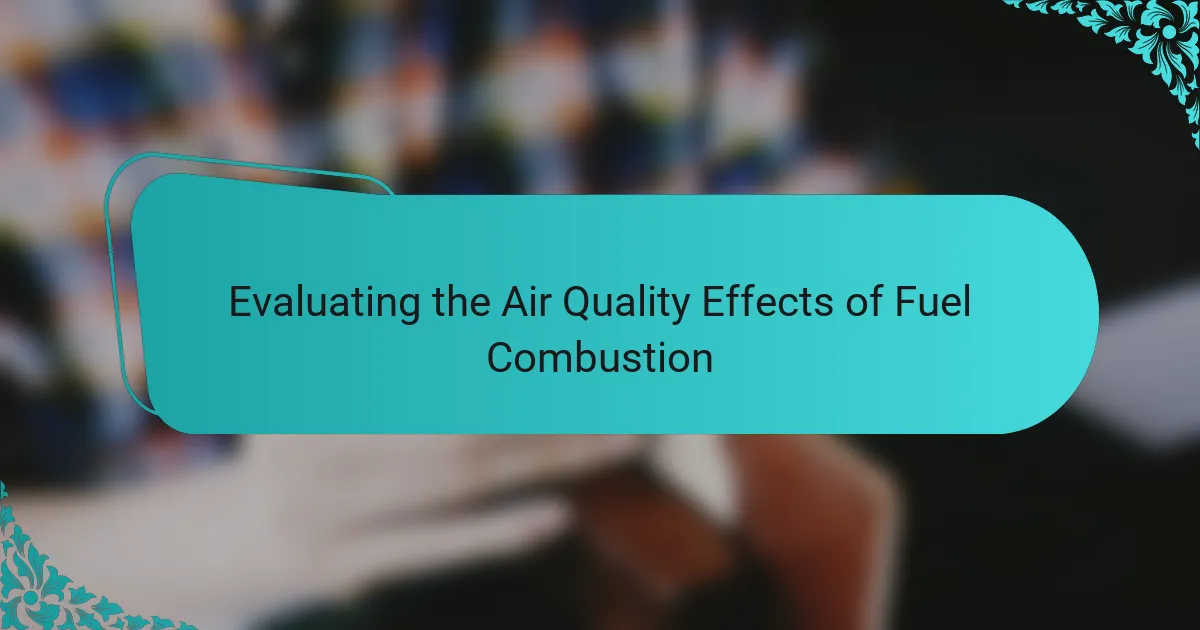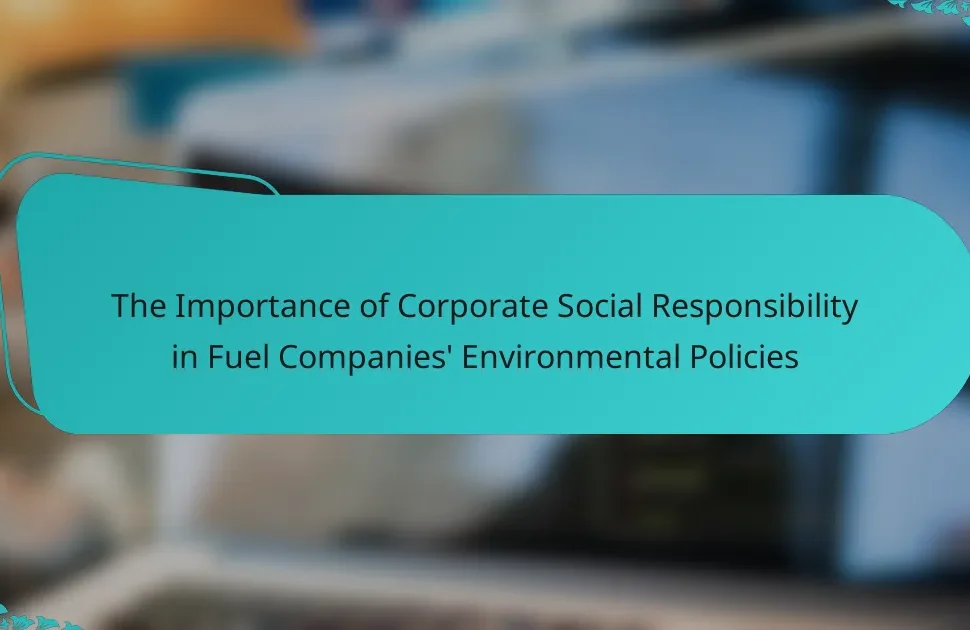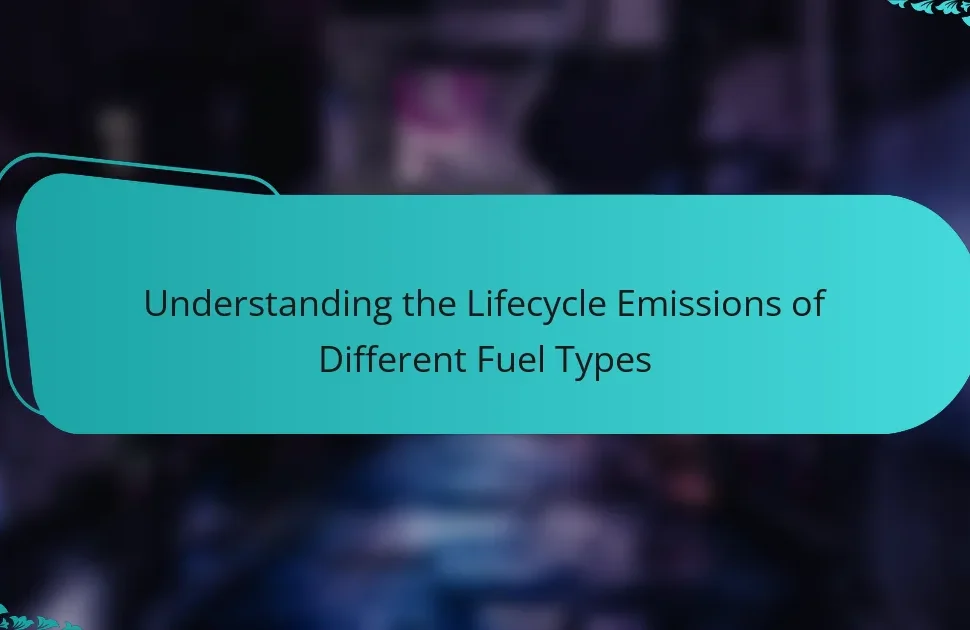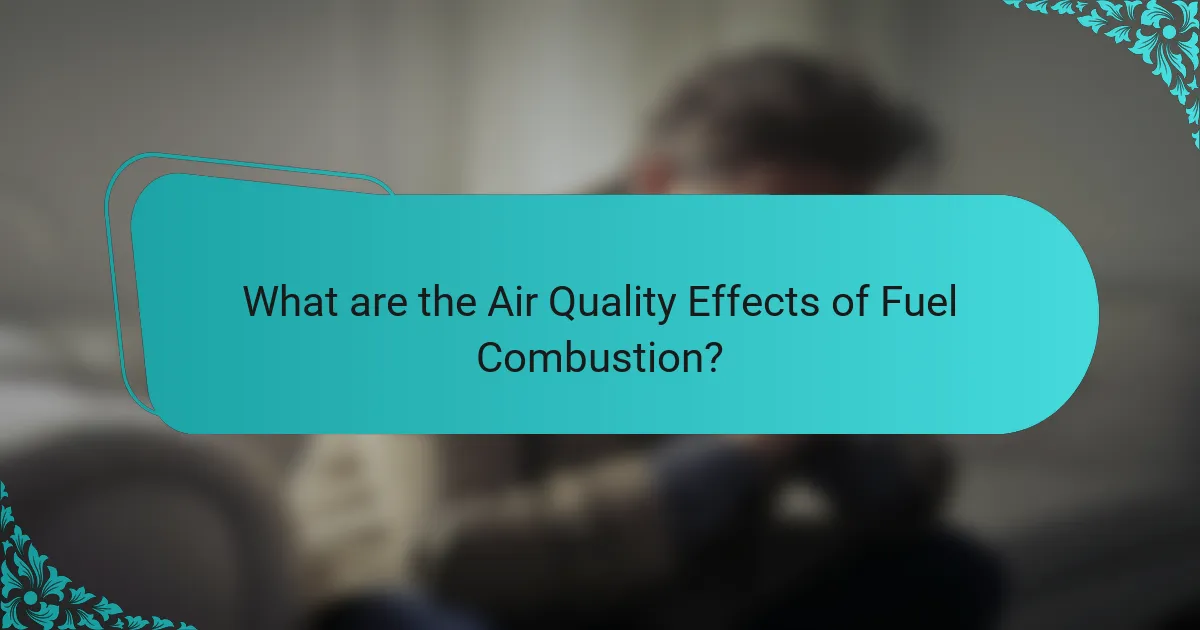
What are the Air Quality Effects of Fuel Combustion?
Fuel combustion negatively impacts air quality by releasing pollutants. These pollutants include carbon monoxide, nitrogen oxides, and particulate matter. Carbon monoxide reduces oxygen delivery in the bloodstream. Nitrogen oxides contribute to the formation of ground-level ozone. Particulate matter can penetrate deep into the lungs and cause respiratory issues. According to the Environmental Protection Agency, fuel combustion is a major source of urban air pollution. Studies show that areas with high fuel combustion have elevated rates of asthma and other respiratory diseases. The World Health Organization links air pollution from fuel combustion to millions of premature deaths annually.
How does fuel combustion impact air quality?
Fuel combustion significantly impacts air quality by releasing pollutants into the atmosphere. These pollutants include nitrogen oxides, sulfur dioxide, carbon monoxide, and particulate matter. The emissions contribute to the formation of smog and acid rain. According to the Environmental Protection Agency (EPA), vehicle emissions are a major source of ground-level ozone. Ground-level ozone can cause respiratory problems and other health issues. In urban areas, fuel combustion from transportation and industry is a leading cause of air pollution. Studies show that reducing fuel combustion can lead to improvements in air quality. For example, the Clean Air Act has resulted in a 70% reduction in major air pollutants since 1970.
What pollutants are released during fuel combustion?
Fuel combustion releases several pollutants. The primary pollutants include carbon monoxide, nitrogen oxides, sulfur dioxide, particulate matter, and volatile organic compounds. Carbon monoxide is a harmful gas produced by incomplete combustion. Nitrogen oxides contribute to smog and respiratory problems. Sulfur dioxide can lead to acid rain and respiratory issues. Particulate matter consists of tiny particles that can penetrate the lungs. Volatile organic compounds are linked to ozone formation and health risks. According to the Environmental Protection Agency, these pollutants significantly impact air quality and human health.
How do these pollutants affect human health and the environment?
Pollutants from fuel combustion significantly impact human health and the environment. Exposure to these pollutants can lead to respiratory diseases, cardiovascular issues, and increased mortality rates. For instance, particulate matter (PM2.5) is linked to over 4 million premature deaths annually, according to the World Health Organization. Additionally, nitrogen oxides (NOx) contribute to the formation of ground-level ozone, which exacerbates asthma and other lung conditions. On an environmental level, these pollutants can lead to acid rain, harming ecosystems and reducing biodiversity. Furthermore, they contribute to climate change by increasing greenhouse gas concentrations in the atmosphere.
Why is it important to evaluate air quality effects?
Evaluating air quality effects is essential for public health and environmental protection. Poor air quality can lead to respiratory diseases, cardiovascular issues, and premature deaths. According to the World Health Organization, air pollution causes approximately 7 million deaths annually. Understanding air quality effects helps identify pollution sources and their impact on ecosystems. It also informs policy decisions aimed at reducing emissions. Effective evaluation supports the development of cleaner technologies and promotes sustainable practices. Monitoring air quality enables timely interventions to protect vulnerable populations. Overall, assessing air quality is vital for safeguarding human health and the environment.
What are the long-term consequences of poor air quality?
Long-term consequences of poor air quality include respiratory diseases, cardiovascular issues, and reduced life expectancy. Prolonged exposure to pollutants can lead to chronic bronchitis and asthma. Studies indicate that air pollution is linked to heart attacks and strokes. The World Health Organization states that air pollution contributes to approximately 7 million premature deaths annually. Poor air quality also affects cognitive function and can lead to developmental issues in children. Environmental impacts include damage to ecosystems and biodiversity loss. These consequences emphasize the need for improved air quality management.
How can evaluating air quality influence policy decisions?
Evaluating air quality can significantly influence policy decisions. Accurate air quality data informs lawmakers about pollution levels. This information helps identify health risks associated with poor air quality. For instance, studies show that high levels of particulate matter can lead to respiratory diseases. Consequently, policymakers may implement stricter emissions regulations. These regulations aim to reduce harmful pollutants from fuel combustion. Improved air quality can enhance public health outcomes. Additionally, informed policies can promote sustainable energy practices. Overall, evaluating air quality is essential for effective environmental policy-making.

What are the different types of fuel combustion?
The different types of fuel combustion are complete combustion, incomplete combustion, and flash combustion. Complete combustion occurs when fuel burns in sufficient oxygen, producing carbon dioxide and water. This type is efficient and releases maximum energy. Incomplete combustion happens with limited oxygen, resulting in carbon monoxide and soot as byproducts. It is less efficient and can produce harmful emissions. Flash combustion is a rapid combustion process, often seen in explosions. It releases energy quickly and can be dangerous. Each type of combustion affects air quality differently, with incomplete combustion being particularly harmful due to toxic emissions.
How do various fuels differ in their combustion processes?
Different fuels have distinct combustion processes that affect their efficiency and emissions. Hydrocarbon fuels, like gasoline and diesel, combust through a series of chemical reactions involving oxygen, producing carbon dioxide and water. In contrast, biofuels undergo a similar process but often result in lower carbon emissions due to their renewable nature.
Natural gas combustion typically produces fewer pollutants compared to coal, which releases higher levels of sulfur dioxide and particulates. Additionally, the combustion of hydrogen generates only water vapor, making it the cleanest option.
The combustion temperature and efficiency also vary among fuels. Higher combustion temperatures can lead to increased nitrogen oxide emissions, impacting air quality. Research indicates that the choice of fuel significantly influences both the combustion characteristics and the resulting air quality effects.
What are the emissions profiles of fossil fuels compared to biofuels?
Fossil fuels emit higher levels of greenhouse gases compared to biofuels. Fossil fuels, such as coal, oil, and natural gas, release significant amounts of carbon dioxide (CO2) when burned. For instance, coal generates approximately 2.2 pounds of CO2 per kWh of electricity produced. In contrast, biofuels tend to have lower net emissions due to their renewable nature. When biofuels are combusted, they can emit around 50% less CO2 than fossil fuels.
Additionally, biofuels can be carbon-neutral, as the plants used to produce them absorb CO2 during their growth. This cycle can significantly reduce the overall emissions profile. Studies indicate that using biofuels can also lead to lower emissions of particulate matter and sulfur oxides, which are harmful to air quality. Therefore, the emissions profiles of fossil fuels are generally more detrimental to the environment compared to those of biofuels.
How does combustion efficiency vary among different fuel types?
Combustion efficiency varies significantly among different fuel types. Fuels like natural gas have higher combustion efficiency, often exceeding 90%. This is due to their cleaner burning properties and lower emissions of unburned hydrocarbons. In contrast, coal typically shows lower efficiency, around 30-40%, because of higher carbon content and impurities. Biomass fuels can vary widely in efficiency, depending on moisture content and combustion technology used. For instance, well-dried wood can achieve efficiencies of 70-80%, while wet wood significantly reduces efficiency. Overall, the chemical composition and physical properties of each fuel type directly influence combustion efficiency and the resulting emissions.
What role do regulations play in fuel combustion and air quality?
Regulations play a critical role in governing fuel combustion and maintaining air quality. They set limits on emissions of pollutants from vehicles and industrial sources. These regulations help reduce harmful substances like nitrogen oxides, sulfur dioxide, and particulate matter. For example, the Clean Air Act in the United States has significantly improved air quality since its implementation in 1970. Studies show that compliance with such regulations has led to a 73% reduction in sulfur dioxide emissions. Additionally, regulations promote the adoption of cleaner technologies and fuels. This shift helps minimize the environmental impact of fuel combustion. Overall, regulations are essential for protecting public health and ensuring cleaner air.
How do emissions standards impact fuel combustion practices?
Emissions standards significantly influence fuel combustion practices by mandating limits on pollutants released during combustion. These regulations require industries to adopt cleaner technologies and fuels. As a result, facilities often implement advanced combustion systems that optimize efficiency and reduce emissions. For example, the introduction of low-NOx burners has been a direct response to emissions regulations. Additionally, emissions standards encourage the use of alternative fuels, such as natural gas or biofuels, which produce fewer harmful emissions. Compliance with these standards often involves regular monitoring and reporting of emissions data. This leads to continuous improvements in combustion practices to meet stringent requirements. Ultimately, emissions standards drive innovation and promote cleaner air quality by reducing harmful pollutants.
What are the challenges in enforcing air quality regulations?
Enforcing air quality regulations faces several challenges. One major challenge is the lack of comprehensive monitoring systems. Many regions do not have adequate resources to track air pollution levels effectively. This leads to gaps in data and enforcement capabilities. Another challenge is the complexity of pollution sources. Emissions can come from various sectors, including transportation, industry, and agriculture. Coordinating regulations across these sectors can be difficult. Additionally, economic considerations often hinder enforcement. Industries may resist regulations due to potential financial impacts. Public awareness and support also play a crucial role. Limited public understanding of air quality issues can reduce pressure on authorities to enforce regulations. Finally, legal challenges can arise. Companies may contest regulations in court, delaying enforcement actions. These factors collectively complicate the enforcement of air quality regulations.
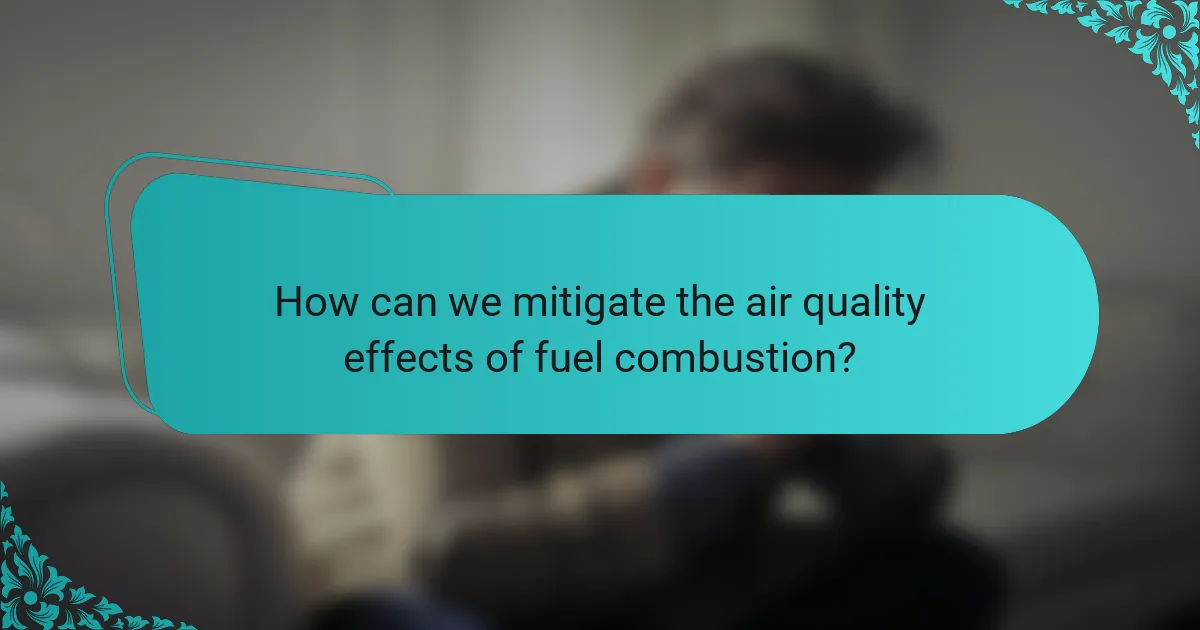
How can we mitigate the air quality effects of fuel combustion?
To mitigate the air quality effects of fuel combustion, we can implement cleaner fuel alternatives. Switching to renewable energy sources reduces harmful emissions significantly. For instance, biofuels and electricity from solar or wind power produce fewer pollutants. Additionally, improving combustion efficiency in engines can lower the release of particulate matter and nitrogen oxides. Regular maintenance of vehicles ensures optimal performance and reduced emissions. Implementing stricter regulations on industrial emissions can also contribute to better air quality. According to the U.S. Environmental Protection Agency, adopting these measures can lead to a notable decrease in air pollution levels.
What technologies are available to reduce emissions from fuel combustion?
Technologies available to reduce emissions from fuel combustion include catalytic converters, scrubbers, and carbon capture systems. Catalytic converters convert harmful gases into less harmful emissions. They are widely used in vehicles and industrial applications. Scrubbers remove pollutants from exhaust gases using a liquid solution. They are effective in power plants and manufacturing facilities. Carbon capture systems capture CO2 emissions for storage or reuse. These technologies significantly lower greenhouse gas emissions and improve air quality.
How effective are catalytic converters and scrubbers in reducing pollutants?
Catalytic converters and scrubbers are highly effective in reducing pollutants. Catalytic converters can reduce carbon monoxide emissions by up to 90%. They also significantly decrease nitrogen oxides and hydrocarbons. Scrubbers, particularly in industrial settings, can remove up to 98% of sulfur dioxide. These devices work by converting harmful gases into less harmful substances. Studies show that the implementation of these technologies has led to noticeable improvements in air quality. For instance, the U.S. Environmental Protection Agency reports that catalytic converters have played a crucial role in reducing vehicle emissions since their introduction. Overall, both systems are essential in mitigating the impact of fuel combustion on air pollution.
What role does renewable energy play in improving air quality?
Renewable energy plays a crucial role in improving air quality by reducing emissions from fossil fuels. The use of solar, wind, and hydroelectric power generates electricity without releasing harmful pollutants. This transition lowers levels of particulate matter and greenhouse gases in the atmosphere. According to the U.S. Environmental Protection Agency, transitioning to renewable energy can significantly decrease smog and acid rain. Studies show that cities utilizing renewable energy sources report better air quality and lower respiratory health issues. For instance, a report by the International Renewable Energy Agency highlights that renewable energy can lead to a 70% reduction in air pollution-related deaths. Thus, renewable energy is essential for cleaner air and a healthier environment.
What best practices can individuals and organizations adopt?
Individuals and organizations can adopt several best practices to improve air quality. Implementing regular monitoring of air quality is essential. This involves using sensors to track pollutants from fuel combustion. Transitioning to cleaner fuel sources can significantly reduce emissions. Renewable energy options, such as solar or wind, should be prioritized. Promoting energy efficiency in buildings and transportation reduces the overall demand for fuel.
Encouraging public transportation and carpooling decreases the number of vehicles on the road. Implementing strict emission regulations ensures compliance from industries. Educating the community about the impacts of air pollution fosters collective responsibility. These practices collectively contribute to better air quality and public health.
How can consumers make informed choices about fuel use?
Consumers can make informed choices about fuel use by researching fuel types and their environmental impacts. Understanding the emissions produced by different fuels is crucial. For example, gasoline and diesel emit higher levels of nitrogen oxides and particulate matter compared to renewable fuels. Consumers should also consider fuel efficiency ratings of their vehicles. Higher efficiency typically results in lower overall fuel consumption and emissions. Additionally, utilizing resources like the U.S. Department of Energy’s Alternative Fuels Data Center can provide valuable information on cleaner fuel options. Consumers can also compare local fuel prices and availability. This knowledge helps in selecting fuels that are both cost-effective and environmentally friendly.
What strategies can industries implement to reduce their air quality impact?
Industries can implement several strategies to reduce their air quality impact. Transitioning to cleaner fuels is one effective approach. This includes using natural gas or renewable energy sources instead of coal or oil. Implementing advanced emission control technologies can also significantly lower pollutant releases. For example, scrubbers and filters can capture harmful emissions before they enter the atmosphere.
Regular maintenance of equipment ensures optimal performance and reduces unintentional emissions. Additionally, adopting energy efficiency measures can decrease overall fuel consumption. This not only lowers emissions but also reduces operational costs.
Participating in emission trading schemes encourages industries to lower their emissions further. Lastly, engaging in community awareness programs can foster collaboration in air quality improvement efforts. These strategies have been shown to effectively mitigate air pollution from industrial sources.
The main entity of the article is the air quality effects of fuel combustion. The article provides a comprehensive evaluation of how fuel combustion contributes to air pollution through the release of harmful pollutants such as carbon monoxide, nitrogen oxides, and particulate matter. It discusses the health impacts associated with these pollutants, including respiratory diseases and premature deaths, while highlighting the importance of assessing air quality for public health and environmental protection. Additionally, the article covers various fuel types, combustion processes, regulatory frameworks, and technologies aimed at mitigating the adverse effects of fuel combustion on air quality.
